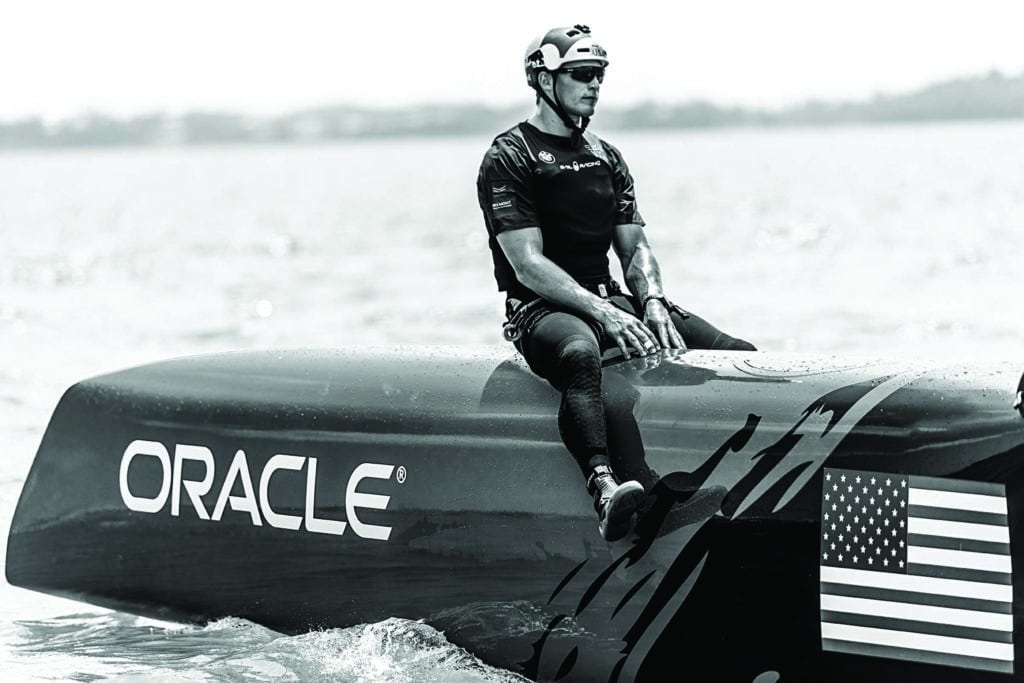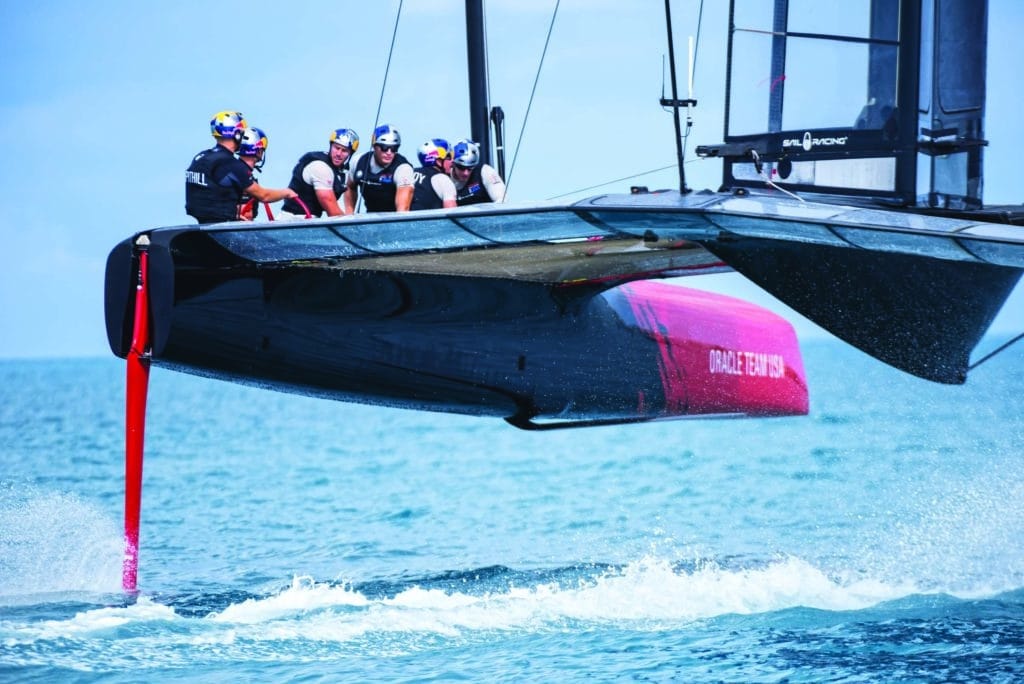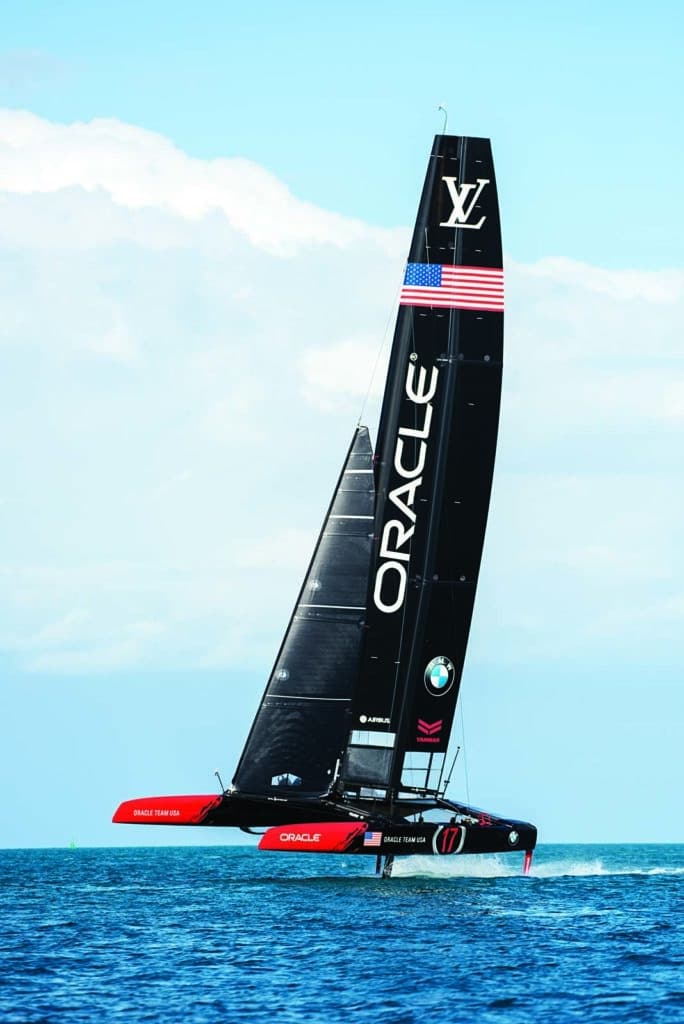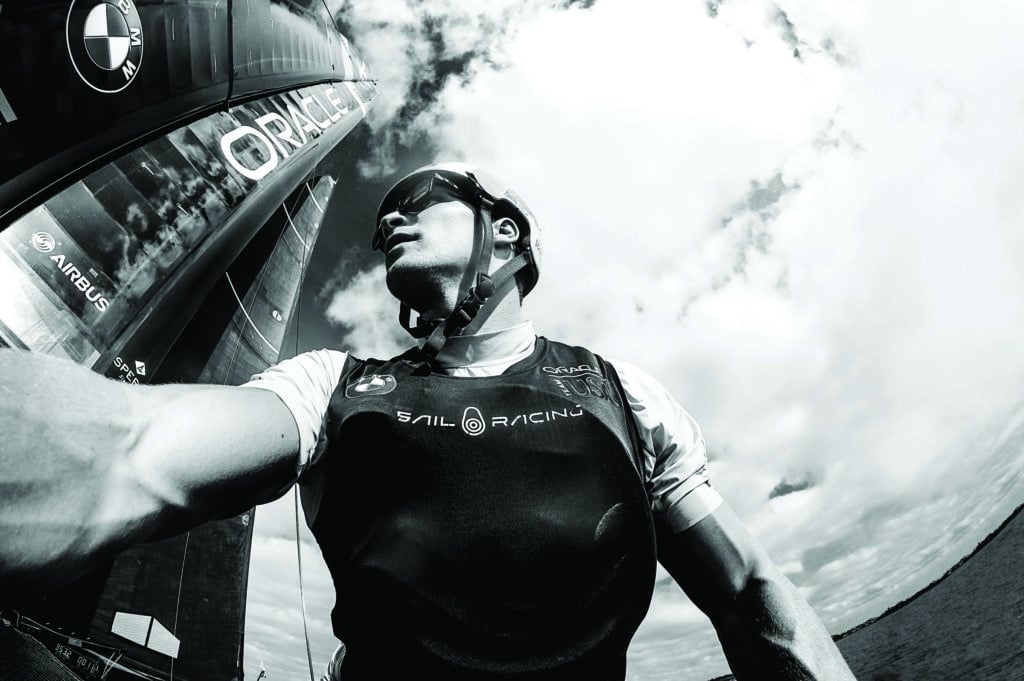
ORACLE TEAM USA training in Bermuda with the AC45S
The order came down the chain of command and landed in Cooper Dressler’s capable hands: Larry needs milk.
“Funny story, but true,” says Dressler, the soft-spoken 26-year-old with steely eyes and chiseled good looks. “Larry was out on his yacht during the World Series event here in Bermuda, and I guess he needed a gallon, so I ran it out to him in our big chase boat.”
If a milk run for billionaire boss Larry Ellison is what keeps him on pro sailing’s most successful juggernaut, says Dressler, then so be it.
One morning in late August, Dressler tells his story — again, I suspect — when we meet at Oracle Team USA’s Bermuda base. We’re inside the cafeteria space, where a small army in black gear scarfs down hot beef sandwiches, roasted cauliflower and salad before the afternoon sailing session. Through a glass wall behind Dressler sparkles Bermuda’s Great Sound, where in less than a year, the 35th America’s Cup will pit five challengers against Ellison’s third defense.
Dressler never — ever — imagined he’d be racing on the sound, especially as a starting grinder alongside guys with salaries and heaps more experience. Yet here he is today — in the gear, on the sailing team, and in the game. As Oracle’s rookie, the San Diego-bred surfer has a Cinderella story pulled straight from some novel of great sporting clichés. Overnight, he went from sweeping floors to standing over a grinding pedestal, shoulder to shoulder with one badass grinder of many Cups past.
Not long ago, Dressler was smiling his way through dirty jobs, helping erect the team’s compound inside Bermuda’s dockyards. More specifically, one day back in August 2016, he was getting a coffee in the cafeteria’s air-conditioned container when team manager Tom Slingsby approached and asked for a quick chat.
“Usually that means they’re going to send you somewhere or have you do some community outreach thing,” says Dressler. “I was nervous.”
They sat opposite each other on couches just off the cafeteria, and Slingsby explained how he and skipper Jimmy Spithill had been watching Dressler progress in the gym. Sculpting bodies into lean, oil-pumping machines is what AC sailors do in Bermuda. Dressler had been working 13-hour days, 26 straight with the shore crew, but started and finished every day with a big workout.
“I didn’t think anyone would notice or care, to be honest,” he says, “but I guess Jimmy and Tom kind of did.”
There were Tuesday and Thursday morning boxing sessions, too, and when the sailing team showed up at 7:30 a.m. for its workout, Dressler and the shore crew would be finishing. When Dressler would step into the ring and square up against a few guys on the sailing team, he pounded the best of them — on account of his reach, he says.
Long, strong and lightning-fast arms are a young wannabe grinder’s best assets, and he’s got ’em.
There’s that, plus a real-deal work ethic, which I hear a lot about as I ramble around the base. It’s all business, all day, as I’m sure it is over at SoftBank Team Japan and Artemis, in England with Land Rover BAR, in France with Groupama, and way down in Auckland with Emirates Team New Zealand. Between workouts, briefings, extracting an nth of a knot from twitchy foiling test platforms, and perfecting foiling tacks, there’s a lot of hay being made.

Oracle’s design and sailing teams are littered with veterans, but there’s new blood too, including 25-year-old backup wing trimmer Tom Johnson, of Australia, who foams at the mouth every time he sails or observes the team’s AC45 Turbo. As we shadow the whistling foiler one afternoon, Johnson’s eyes remain locked on the boat, scanning its every nuance. He rarely looks away except to jot a note in the miniature waterproof notepad he keeps always in hand. With a foot in the door, he too says he’s incredibly fortunate. AC gigs are rare. Skill is only half the package. The rest is attitude.
That’s how trimmer and boat captain Matt Cassidy, of Chicago, got here as well. He’s the 38-year-old stud of a bowman from the grand-prix big-boat circuits, but before joining the team in 2014, the extent of his cat experience was a Hobie 16. As boat captain, he now oversees the most advanced 45-foot catamaran in sailing. Then he goes out, grinds his heart to redline, and helps put the boat away each night.
“I’d never been a boat captain before, but I’ve been around a lot of good ones,” he says early one morning as he readies the boat for the day’s tests. “But that’s the responsibility I’ve taken on. Getting on these boats has been like learning to sail again. Every day is a crash course.
“I felt out of my league when I started, but honestly, I think one of the reasons I was hired is because of my persistence, and I work hard. With these teams, it’s very much a personality thing.”
Hard work nets reward, and for Cassidy, the reward comes every day. “It’s not just physical; it’s more cerebral than anything I’ve ever done,” he says. “Forty knots is pretty incredible. Less than 20 knots, I feel like I’m not even moving. Thirty knots is no big deal. Then, at 40, when I feel the shuddering, I know I’m cooking. It’s just so awesome. It’s tiring but rewarding.”
The entire team — and that includes the geeks over in Building 9, led by Scott Ferguson, of Jamestown, Rhode Island — is “more complete” this time around, says managing director Grant Simmer, the silver-haired old guard of numerous Cups past. The team has thinned out “complacent old-timers” and recruited from within to build what Simmer boasts is the most compatible sailing team of all the previous three campaigns. For a team that staged the greatest comeback in sailing, that says a lot. Simmer too mentions work ethic in passing, as does coach Philippe Presti, who was instrumental in orchestrating the great defense of 2013. His workspace is in Building 9’s high-ceiling briefing room. Three desktop monitors line his desk, and on the wall are six large flat-screen TVs displaying a spreadsheet, a strip chart, and paused videos showing numerous points of view on the boat.
Presti is the team’s sailing coach, but he’s also a shrink for the vets and a guru for eager nippers like Dressler.
“We both play guitar, so we built a band together,” says Presti, laughing. “He’s an awesome drummer, too. That guy’s talented at everything he does.”
As a coach to the sport’s best, he’s not always nice, especially to rookies. “In the debrief after sailing, we show what we’ve done,” he says, pointing to the screens, “and there’s nothing to hide, so it can be rough sometimes, especially for the newcomers. But if they want to be athletes and want to improve, they have to want to know what works and what’s important, and from there, they build confidence.”

ORACLE TEAM USA training in Bermuda for the AC45S
The younger guys, he says, are more receptive to criticism. Plus, they’re more connected with images and video, so they are more accepting of it.
Presti says Dressler came to the team shouldering “the right attitude,” but was unproven as a sailor. “After an hour in the Moth, he could fully jibe,” says Presti. “I think he’s the best foiler in the group. He’s talented, a hard worker, and in his position, he is a very strong guy.”
He’s also one of four Americans on the sailing team, including Cassidy, Rome Kirby and Andrew Campbell, Oracle’s backup tactician, who is also on his first Cup campaign.
“When we first got here, Cooper was literally installing air-conditioner units and dragging conduit through the trenches with local guys,” says Campbell. “When we got heavy into the two-boat testing, it became obvious we needed another full-time grinder, and his name came up a lot. There was no one here working harder than Cooper.”
It also helped that Dressler was a familiar face around the compound, having mentored with the team in 2014 as a crewmember with the scrappy American Youth Sailing Force entry in the Red Bull Youth America’s Cup. Once that gig ended, Dressler, a graduate of UC Santa Cruz, stuck around Oracle’s base, taking all jobs thrown his way. When the team defended in San Francisco, he was there to soak it all in, and the awesomeness of it, he says, affirmed his true calling. “[With the Youth Sailing Force] we didn’t convince anyone we were good enough to jump on boats as professional sailors,” he says, “so I had to sort of start over and get in with the shore team. I don’t think anyone actually knew that I knew how to sail.”
When the offer came to help decamp to Bermuda, he jumped. “Here was my opportunity to just do whatever I’m asked, and if it happens, it does,” he says. “My friends were like, ‘Whoa, you’re working with Oracle? That’s so cool.’ And I was like, “Dude, come help us break down the base.’ I said I could get them a job, but no one wanted to do it. I don’t think any one of them saw what opportunity there was, and frankly, I didn’t either.” Next thing you know, he’s on the sailing team.
Being a known quantity is an important part of the Cup culture today, says Campbell, adding that the team is a best-fit scenario rather than one exclusive to elite sailors. He likens it to the 2016 men’s U.S. Olympic basketball roster, which had more compatible players than prima donnas.
As a grinder powering the mainsheet winch, a prima donna Dressler is not. But he is a big cog in a sailing machine. When Slingsby tapped Dressler to be the wattage-delivery man to 27-year-old wing trimmer Kyle Langford’s every little wing-sheet adjustment (and there are many), Dressler transformed from shore crew to full-time grinder overnight. He put on 25 pounds for the job, but it’s all lean muscle mass and he’s quick as a whip.
“I wasn’t confident I’d be able to play in the same league with the other guys, but I surprised myself with the [physio] testing. It turns out I’m pretty good at the grinding. I’ve always been stronger lower body than upper body,” he says.
His physical traits include being very well rounded in three physiological energy systems, says Craig McFarlane, Oracle Team USA’s physical performance manager. Most athletes are blessed with being good over one or two systems; Dressler excels in all three.

ORACLE TEAM USA training in Bermuda for the AC45S
“His oxidative system, which is his body’s ability to supply fuel and energy over long periods, means Cooper can grind all day, sustaining more than 300 watts continually over a 25-minute race. That’s up there with what professional road cyclists can do with their legs,” says McFarlane.
His glycolytic system, which controls his ability to tolerate and flush lactic acid, is highly efficient, which allows him to repeatedly produce multiple blocks of very intense work with very short recovery. The third system is what’s called the ATP-PC system, says McFarlane, which is basically the most power, measured in watts, that Cooper can generate on the pedestal in three to six seconds. “For a comparison in cycling, he can produce more than 1,600 watts with his upper body, which is similar to what Tour de France cyclists can produce with their legs.”
Months into his new gig, Dressler can still hardly believe his situation: young, single, sailing at the top of his sport, and holed up in a remote North Atlantic resort island chain where he can kiteboard and sail a Moth all he wants in his free time. It’s also his first paid sailing gig, and he laughs at the fact that he has no idea what he should be earning. “I’m just happy to be here,” he says, straight-faced. “I’ll take whatever they give me.”
In August, during my visit, the sailing team has just returned from an America’s Cup World Series event in France, in which they finished last. Spithill is off-island, on the mend from surgery, so the week’s testing and training sessions resume with Slingsby behind the AC45 Turbo’s little red wheels. The AC50 is coming in December, so now’s the time to make hay.
The day’s priority list includes a look at “Board 9,” which is slotted into the port hull. Benchmark Board 1 is in the other hull. Also on the list are a new internal wing-adjustment system, experimentation with rudder rake, and checking the boat’s takeoff speeds. All these exercises are only a few of the mind-bending matrix of variables the team must get right before its first race next June.
On board the RIB “test boat,” which shadows the AC45, there’s a dashboard-mounted monitor with 22 different data points, a polar diagram, and a two-dimensional image of the boat, showing its three-dimensional motion in real time. Ian Burns, director of performance, drives the RIB with his right hand and mans a laptop to his left, recording test runs and typing notes after each one ends. After more than three hours, I count 38 individual tests before the final speed run of the day.
Slingsby reports a rudder-rake adjustment over the radio. Burns copies and records another test on his laptop. Dressler and his fellow grinders put their backs into feeding the maze of oil-hungry hydraulics. The big wing’s trailing element swings to centerline, the bows sweep away from the wind, and the boat lurches forward with spray spewing off the foils. The 2-ton black catamaran lifts free of the water and teeters on Board 9. Burns pushes the throttle forward, the Yanmar engine underfoot roars to life, and the chase is on. And there’s Dressler, head down at his new job, grinding away.
No more milk runs for this guy.









